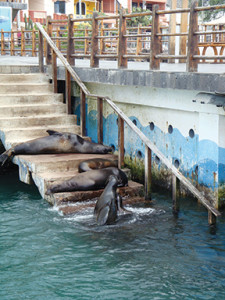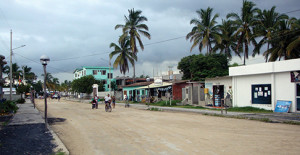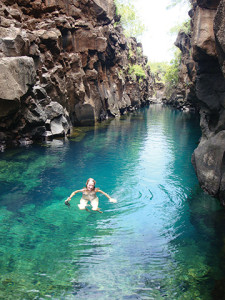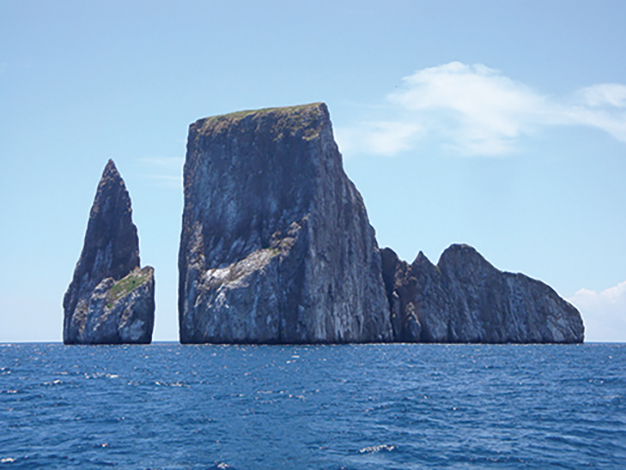A month relaxing and repairing in the islands of enchantment (published January 2012)
In early February 2011, the schooner One World left the beautiful, pristine Las Perlas Islands of Panama, running downwind under full sail on a fresh northerly breeze, bound for Las Islas Encantadas, as the Galapagos were originally known.

As the strong north wind whisked us out of the Gulf of Panama, rolling along at 8 to 9 knots the first night out, hopes of a quick passage began to blossom. But on the second night, when we were down to less than 5 knots of wind, I decided to alter course for mainland Ecuador for a refueling and rest stop. On day five, we crossed the river bar into Bahia de Caraquez, just south of the equator on Ecuador’s coast. We spent almost two weeks in and around the somewhat crumbling but tranquil resort town, provisioning and traveling up to the nearby Andes. We explored adrenaline-charged Quito, laid back Otavalo and charming little Cotacachi, while some of our crew traveled to the headwaters of the Amazon to visit indigenous tribes in the rainforest—only a day’s bus ride away over the impressive snow-clad mountains. Ecuador was a pleasant surprise with a varied landscape, friendly people and many national parks, historic sites and breathtaking vistas.
At the end of February, we finally left for the Galapagos and made the run—mostly with a favorable current—in four-and-a-half days. We had virtually no wind until the final day out, but thanks to near real-time current data from NOAA, we made good progress. As we came in along the north coast of San Cristobal Island, we fell in with a good following breeze, passing the famous Galapagos landmark “Kicker Rock” under full square sail and raffee.
When planning to visit the Galapagos, the biggest dilemma most captains have is the decision of whether or not to buy a cruising permit. According to what we learned prior to leaving, recent regulations have made it possible to stop in one of the two main inhabited ports in the Galapagos for up to 21 days without the need for advance authorization or permit. We learned that for an additional $300 or so, it is possible to apply in advance for a permit called an Autografo, which allows you to stop at all five inhabited ports and stay up to 30 days, with the possibility of an additional 30 days at the port captains’ discretion. We chose not to get the Autografo because we believed we would only be there for a week before pushing on toward the Marquesas. Impending events were to prove us wrong.
A NOISY WELCOME

Because of recent rains, the island of San Cristobal loomed on the horizon like a bright emerald gem. Shortly after sunrise on our final day out, with the island less than 25 miles away, the wind finally came up out of the east and drove us at nearly 6 knots under full downwind rig. By early afternoon, we were closing in on the busy little port of Wreck Bay, also known as Puerto Baquerizo Moreno and so shown on modern charts.
Picking our way in through the 20 or so cruising yachts from all over the world and the 50 or more commercial fishing craft anchored off the town docks, we found a place in 30 feet of water to drop our hook. Within minutes, two different water taxis came by with “agents” aboard offering to check us into the Galapagos. We told them that we had already had contact with a man named Bolivar Pesantes Palma who has an agency called Naugala, and they sped away, disheartened. Bolivar is probably the best known agent in the Galapagos, and from what we were to learn in the coming weeks, he has the best connections and infrastructure to support the special needs of cruising yachts. Several of our friends had recommended that we use Bolivar and we were happy to see him arrive an hour later with the national park, immigration, health and port officers all crammed into one of the many water taxis zooming to and fro in the busy anchorage. Once on board, he quickly and efficiently took charge of getting us through the numerous forms. Within half an hour, Bolivar assured us it was okay to go ashore.
Landing at the main water taxi dock was chaotic and somewhat dangerous. The floating dock rose and fell in the ever present surge, had a constant flow of people coming and going, and was shared by obstinate and vociferous sea lions. We turned and trudged up the steep ramp to the main pier, weaved our way past more smelly, noisy sea lions, then walked down the length of the concrete pier into town. After all of the misinformation we had heard or read on the Galapagos, exploring the town proved that it was a bustling, appealing port, and in fact a pretty good place to stock up on basic supplies and parts for the boat.
We spent the next 10 days in and around Wreck Bay. The younger crew surfed nearly every day and the girls often swam with the baby sea lions, who were always eager to play games and perform underwater acrobatics for us. Melanie had experience in synchronized swimming and became a favorite of the pups that abound in the bay, always ready to frolic. We were still in port when reports came in of the tsunami in Japan. All the boats were instructed by the port captain to leave the harbor and were only allowed to re-enter after dark once the final waves had gone by. After the tsunami, we took a ferry ride over to Santa Cruz and then ventured on to Isabella Island, which we found to be the most fascinating of the three main islands.
In Wreck Bay, there are several decent grocery stores. Two of them, the Gala Markets, had enough in stock for a basic provisioning, although prices were about one-third higher than in mainland Ecuador. There was also a surprisingly well-stocked hardware store and several smaller shops with a good selection of belts, hoses, plumbing and electrical supplies.
ANY EXCUSE TO STAY
On what we thought was our final day in San Cristobal, I was making a routine inspection of the boat’s systems and discovered a crack in one of the hydraulic fittings in the steering system. With some diligence, we were able to craft a temporary repair with parts from several of the small shops. This allowed us to leave for Santa Cruz, where we believed we could find more assistance.
We made the run over to Academy Bay under power in about seven hours and found a spot not too far from the main docks in 20 feet of water. Academy Bay is not nearly as well protected as Wreck Bay and is usually very rolly, but we managed to spend several pleasant days there on an emergency forced entry, which we secured from the port captain with Bolivar’s help while we had new hydraulic hoses made. There is a very good marine store in Academy Bay called Bodega Blanca, which carries an unusually wide selection of marine parts, from watermaker membranes, hydraulic pumps and fittings to braided line, plumbing and electrical parts. We found Racor filters there at better prices than in the States, and they had English speaking help on the floor to assist us. After a few days fitting the new parts, we finally cleared and left for the Marquesas.
A day out from Santa Cruz, while in the lee of Floreana, I did another inspection of our steering system and found that one of the high pressure bleed valves that I had not replaced was leaking. Rather than turn back toward Academy Bay, we decided to alter course northwest for Isabella Island and Puerto Villimar, the westernmost inhabited port in the Galapagos, where we hoped we could have the part we needed shipped in to us. We enjoyed a great sail over to Floreana and ended up spending the night in the lonely, open roadstead anchorage. No one came out to us, or even appeared to notice us and we left at first light for Isabella.
EASY DOES IT
Isabella is the largest island in the Galapagos and has five volcanoes, including the second largest caldera in the world. Once again, Bolivar came to our rescue and with his local representative, Jesse DeSoto, managed to get us permission to stay for a few days while the necessary parts were shipped in from Santa Cruz.
Isabella is mostly wild and undeveloped, with only its southern portion accessible by road or trails. Puerto Villamil is the best sheltered anchorage of the five that yachts are allowed to visit in the group and has many penguins, blue-footed boobies and sea lions. Thousands of marine iguanas cover the dark volcanic rocks of the islets that shelter the anchorage from the Pacific swells, and a quaint settlement with sand streets and tiny beachfront restaurants and hostels made this our favorite stop.
While there, our crew made the ascent to an active volcano, swam with penguins and got to know the local surf spots. Diesel was cheaper than in the other main ports, and we found out that contrary to what we had read, even if you do not decide to get an Autografo, an agent can arrange for your one port of entry in the Galapagos to be Isabella Island. The shopping is more limited than in Wreck Bay or Academy Bay, but the pace of life is slow and easy.
The anchorage is well protected. Penguins swam under the boat while young sea lions tried to get Melanie and Gayle to join them in the cool, clear waters of the harbor. The people were very friendly, the children polite and playful. There is a large and successful tortoise breeding center on the western edge of town and the beaches are the best in the Galapagos. Surfers come from all over the world to surf the breaks, and our time there will always be a cherished memory.

With the repairs finally complete, we reluctantly took leave of the enchanted isles with hopes that one day we may return. If we do, we’ll head straight for Isabella Island and perhaps even get the Autografo so we may spend as much time there as regulations permit.
Todd Duff and Gayle Suhich recently sold their schooner One World in Panama and have purchased a classic Westsail 42 ketch, Hull #1. They are currently outfitting the new boat, which they have named Small World, and will be back in Panama to continue their adventures this winter and beyond.















